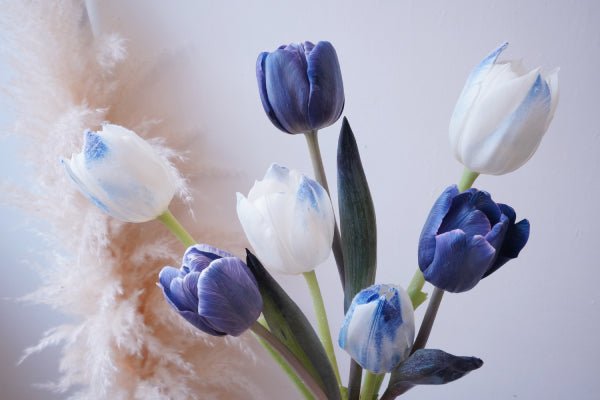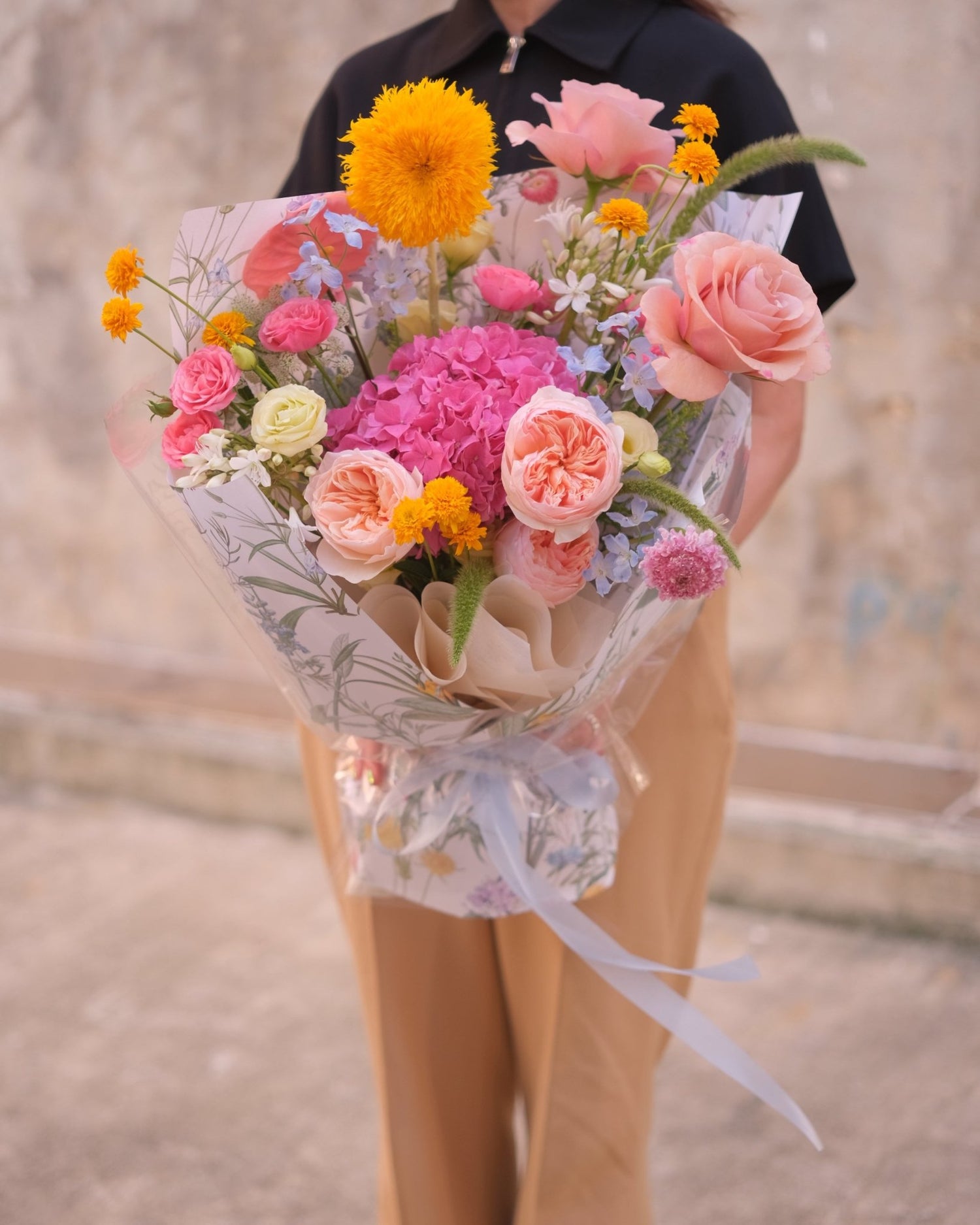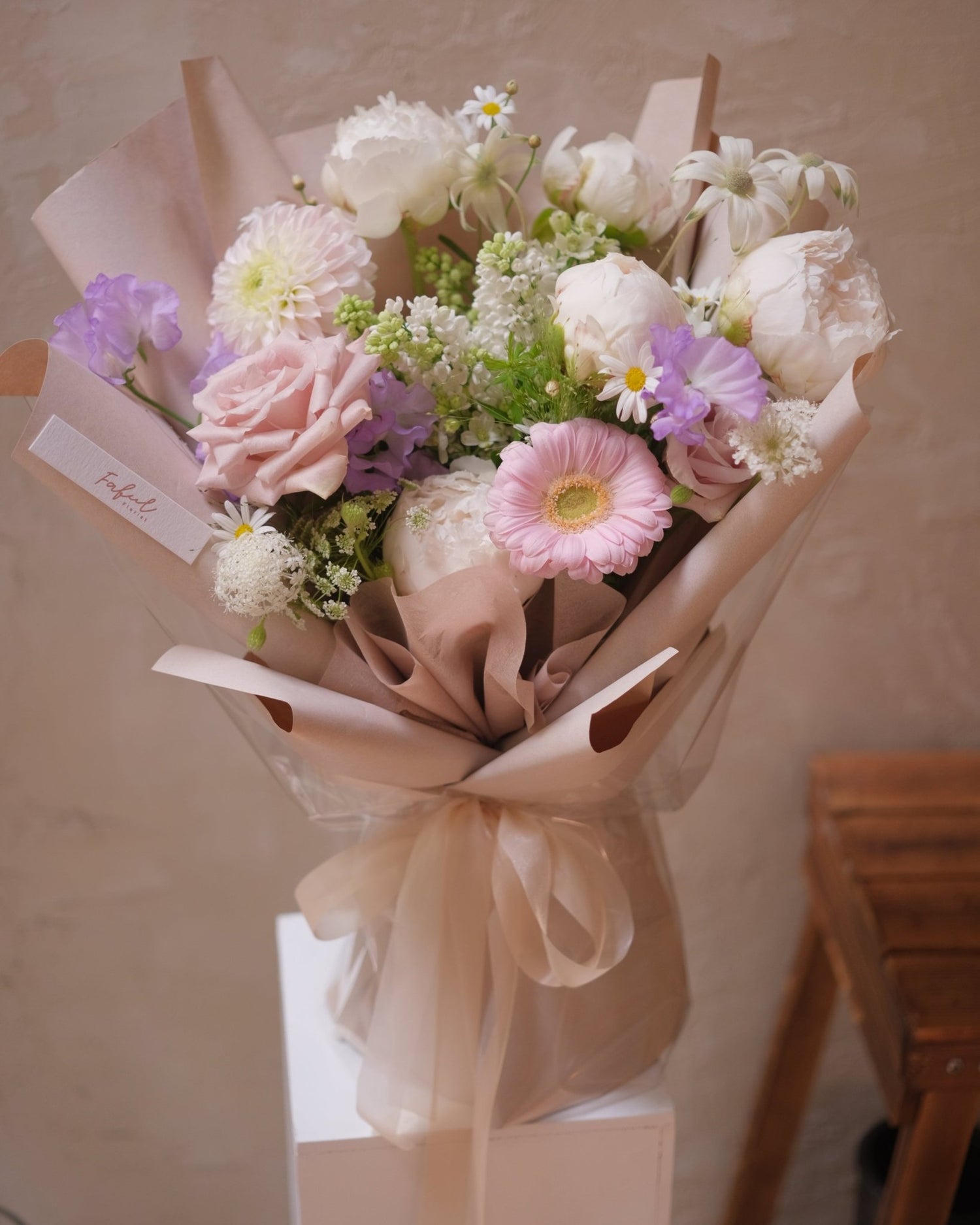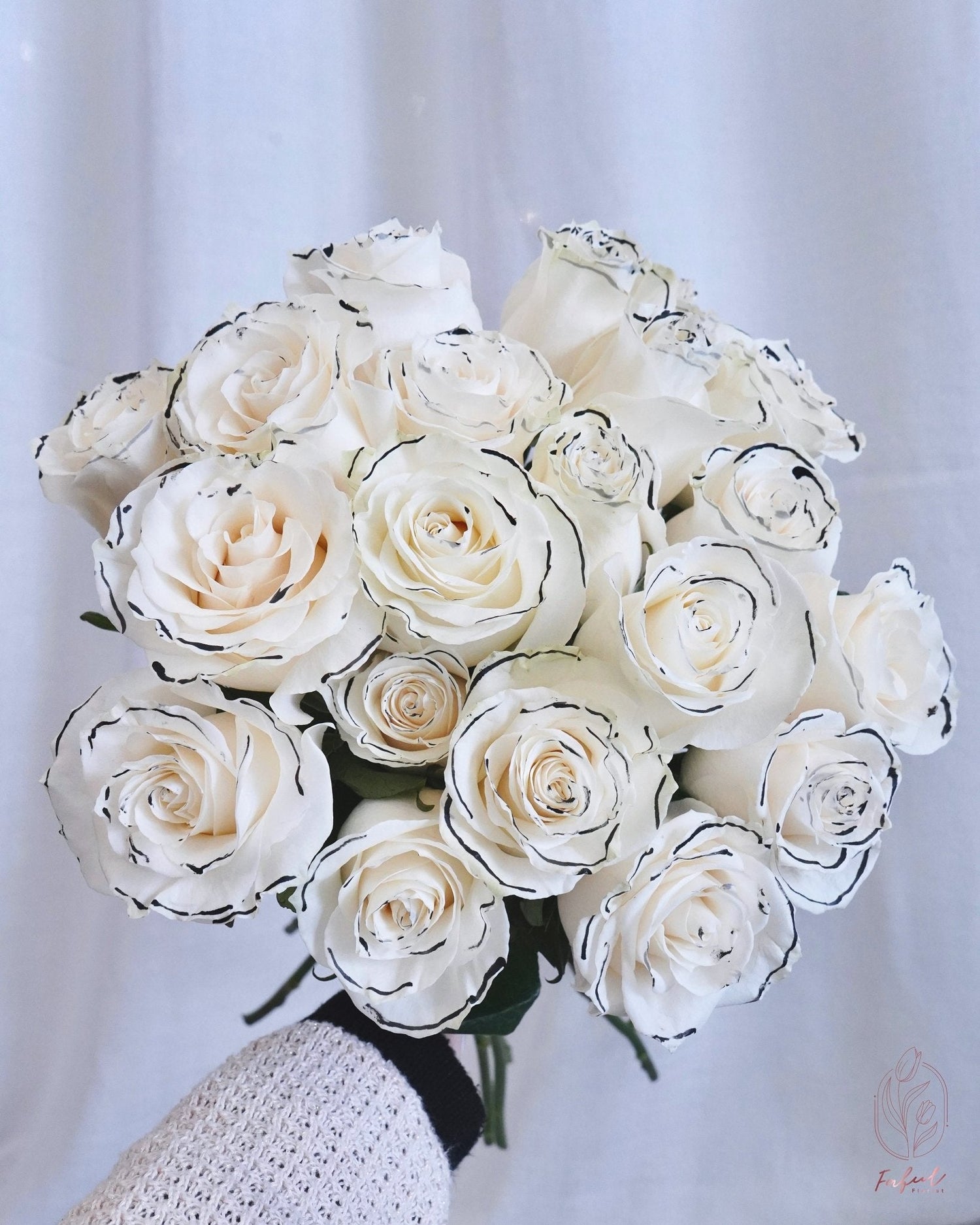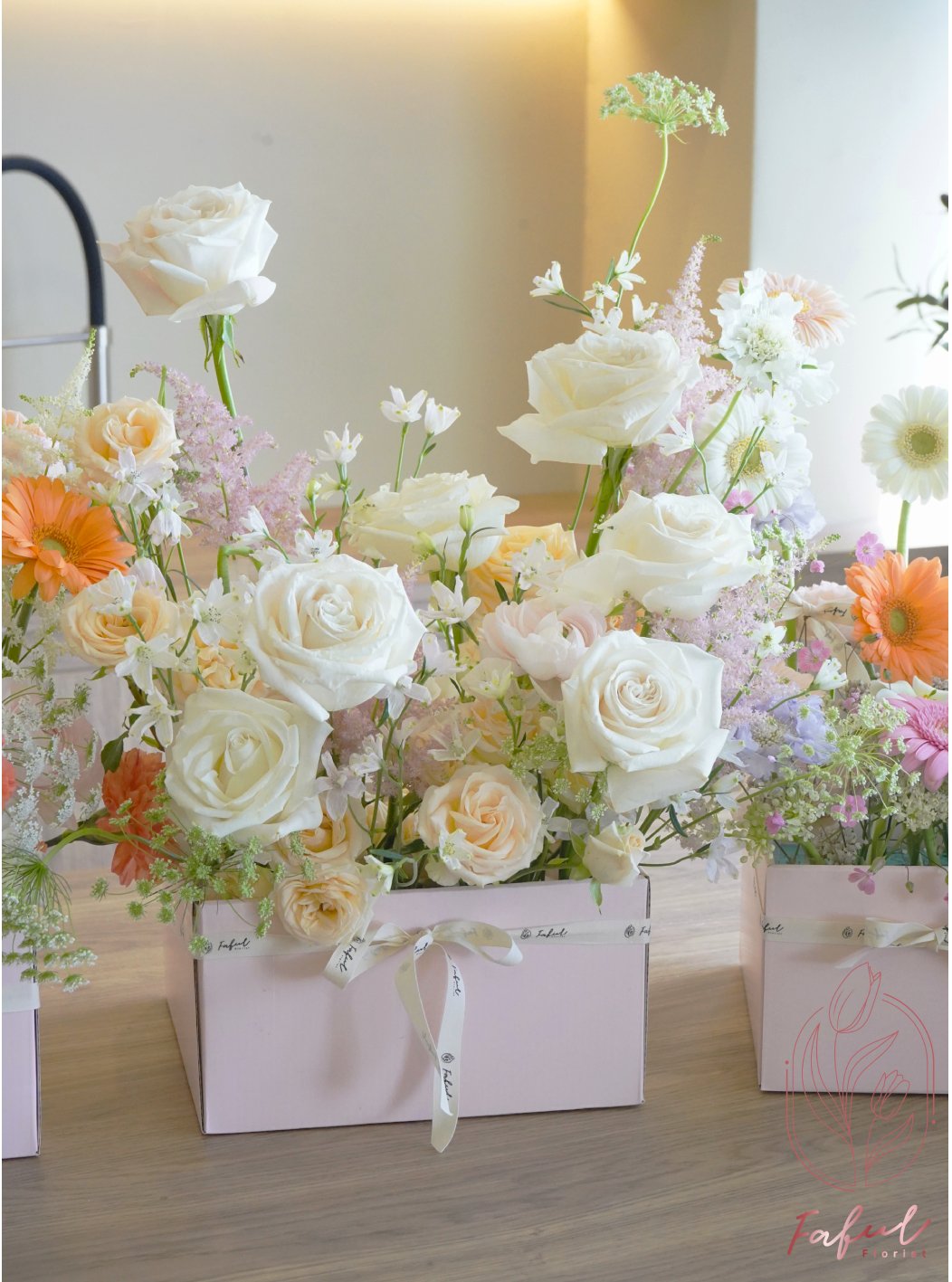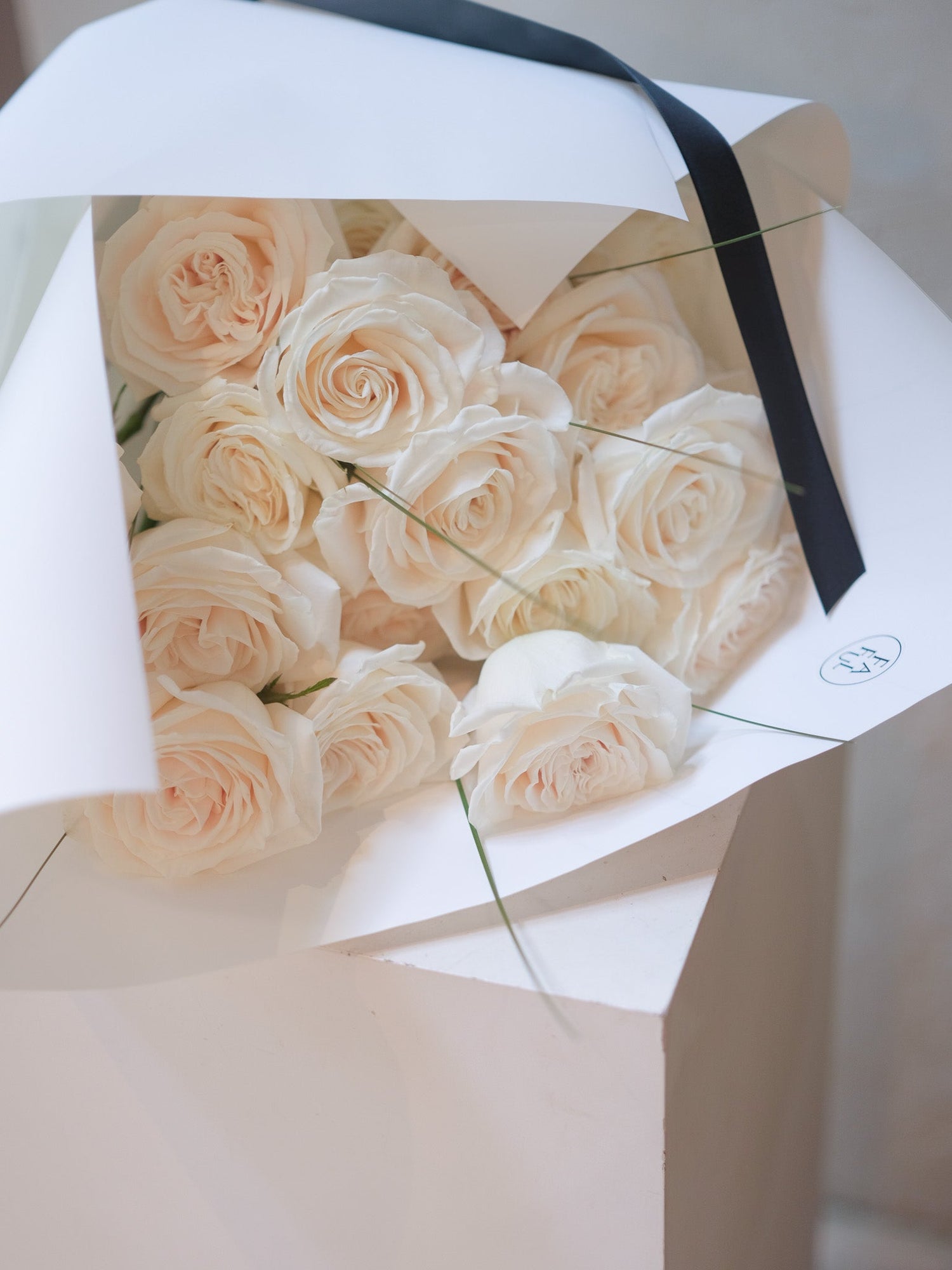
Florist's Fresh Flower Care Guide - Keep Your Fresh Flowers and Roses Blooming Longer
Estimated reading time: 7 minutes
Fresh flowers, with their splendid colors and fragrant aromas, add infinite vitality and joy to living spaces. Whether it's roses or carnations received on holidays, or a carefully selected bouquet, we all hope this beauty can last as long as possible. However, fresh flowers are delicate lives, and their preservation period is very limited after leaving the nourishment of their roots and stems. Fortunately, by mastering the correct methods of fresh flower preservation and care, we can greatly extend their viewing period, allowing the fleeting beauty to linger longer. This article will detail basic care steps, advanced maintenance techniques, and the art of caring for roses, helping you become a master of flower preservation.
Table of Contents
- Basic Flower Care: First Steps After Receiving a Bouquet
- Advanced Flower Preservation Techniques: Secrets to Extending Flower Life
- Rose Care Corner: Nurturing Your Romance
- Care Tips for Other Common Flowers
- Myths and Common Mistakes in Flower Preservation
- Summary and Quick Reference Guide
- Flower Care Key Points Summary Table
Basic Flower Care: First Steps After Receiving a Bouquet
Prompt basic care after receiving fresh flowers is the crucial first step in determining the lifespan of the bouquet.
Process Immediately
The golden rule of flower care is "speed." Flowers should be processed as quickly as possible because they dehydrate rapidly after being out of water. The sooner they absorb water, the better their condition will recover, and the longer their preservation period will be.
Unwrap the Packaging
Although bouquet packaging is beautiful, it obstructs air circulation, easily accumulates moisture and heat, and accelerates bacterial growth and decay. Carefully remove all packaging to let the stems and leaves "breathe." You can temporarily leave the binding tape on for easier handling.

Prepare the Vase
Cleanliness is key to flower preservation. Choose a vase of appropriate size and thoroughly clean the inside with detergent to remove dirt or bacterial film. If necessary, you can disinfect it with diluted bleach (about 1:10), but be sure to rinse it thoroughly. A clean vase reduces bacteria and is a guarantee for extending the flower's life.
Trim the Stems
This step is crucial. During transportation, stem ends may have dried out, been crushed, or blocked by air, affecting water absorption. They need to be trimmed with a sharp, clean tool.
-
Angle: Cut at a 45-degree angle to increase the water absorption area and prevent the bottom from sitting flat and hindering water uptake.
-
Position: Cut off at least 2-3 cm from the end of the stem. If the end is dry, cut off more.
-
Method: It is recommended to make an angled cut with a sharp, clean tool in the air, then immediately place the stem in water to ensure the cut end can quickly absorb water. Some also advocate cutting stems underwater, believing this can more effectively prevent air from entering the vessels and forming an "air lock" that obstructs water absorption; however, others point out that cutting underwater might draw in impurities or bacteria from the water. Regardless of the method, the key is to use a clean tool, complete the cut quickly, and ensure the stem has immediate access to clean water.
- Frequency: Re-trim the ends by 1-2 cm each time you change the water to keep the cut fresh.

Remove Excess Leaves
Inspect the stems and remove all leaves that will be submerged in water. Leaves in water will rot, contaminate the water, breed bacteria, clog the vessels, and shorten the lifespan. Keep the leaves above the waterline.
Add Fresh Water and Preservative
Fill a clean vase with an appropriate amount of clean fresh water. Regarding water temperature, for initial processing, consider using lukewarm water (about 37-43°C) to help the stems quickly absorb water and recover vitality. For daily water changes, cool or room temperature fresh water is recommended. Note that some flower species (like tulips) may prefer cold water.
Fill with an appropriate amount of clean fresh water, ensuring all stem ends are submerged. Generally, the water level can cover one-third to one-half of the stem length, but the optimal water level varies by flower type (e.g., roses need deeper water, while tulips and gerberas need shallower water, see subsequent sections for details). Avoid water levels that are too low, which can lead to insufficient water absorption.
Be sure to add flower preservative, which usually contains: 1. Sugar (energy); 2. Acidifier (aids water absorption); 3. Biocide (inhibits bacteria). Dilute accurately according to instructions. If no preservative is available, the effect will be slightly inferior; the alternative is to maintain extreme cleanliness and change the water frequently, avoiding home remedies.

Advanced Flower Preservation Techniques: Secrets to Extending Flower Life
After completing basic care, daily flower maintenance is equally important. Advanced techniques can make flowers bloom longer.
The Science of Placement
The placement of fresh flowers has a direct impact on their lifespan:
- Avoid Direct Sunlight: Strong light accelerates water evaporation and aging, leading to scorching and fading. Choose a bright indoor spot without direct sunlight.
- Keep Away from Heat Sources: Do not place near heaters, air conditioning vents, or heat-emitting appliances. High temperatures accelerate water loss.
- Avoid Strong Drafts: Strong air currents accelerate water evaporation, leading to dehydration.
- Keep Cool: Temperature affects lifespan. Place in a cool indoor area as much as possible. Lower nighttime temperatures slow down decay.
- Keep Away from Ripe Fruit: Ethylene gas released by ripe fruit accelerates flower maturation and aging. Be sure to keep them separate.
Water Quality and Changing Frequency
Keeping the water source clean is central to flower preservation.
- Water Changing Frequency: It's best to change the water daily, or at least every other day. Change immediately if the water quality deteriorates.
- Water Choice: Use clean, cool, or room temperature tap water. If concerned about chlorine, let it sit or use filtered water.
- Replenish Water Level: Fresh flowers absorb water daily; monitor the water level and replenish promptly, ensuring stem ends are submerged.
- Clean the Vase: Rinse the inside each time you change the water. Thoroughly clean and disinfect every few days.
- Re-trim Stems: Re-trim the stem ends each time you change the water to ensure unobstructed water absorption.

Make Good Use of Flower Preservative
Make good use of flower preservative: Preservative is an effective tool. Try to get some. Add a new solution according to instructions each time you change the water; do not reuse old solution.
Mist with Water for Hydration?
Mist with water for hydration? In humid Hong Kong weather, it's usually unnecessary. However, for flowers requiring high humidity (like hydrangeas) or in dry, air-conditioned rooms, occasional light misting can be done. But excessive misting can easily lead to water accumulation and fungal diseases (especially for roses and carnations). Misting should be done cautiously, ensuring good ventilation.
Dealing with Withered Flowers and Leaves
Dealing with withered flowers and leaves: If you find wilted flowers or yellowed, decaying leaves, remove them immediately. They affect aesthetics, release ethylene which accelerates aging, and can become a breeding ground for pathogens. Timely cleanup helps maintain the health of the bouquet.
Rose Care Corner: Nurturing Your Romance
Roses are one of the most popular fresh flowers, and their flower care has unique points that require extra attention.
Special Needs of Roses
Roses require a large amount of water, and the water quality must be clean. Their stems are easily clogged by bacteria, and they are quite sensitive to ethylene.
"Conditioning" and "Reviving"
Roses that have just been received, especially after long-distance transport, may be dehydrated. "Conditioning" or "reviving" them can help them quickly regain vitality.
- Preparation: Unwrap, remove leaves and thorns below the waterline.
- Stem Trimming: Cut stems at a 45-degree angle underwater (3-5cm).
- Deep Water Soaking: Place them in a deep bucket of warm water (about 37-43°C) with preservative, with the water level as high as possible. Warm water helps faster water absorption.
- Placement: Let them sit and absorb water in a cool, dark, draft-free place for at least 1-2 hours or overnight, allowing them to fully hydrate and perk up.
- Transfer to Vase: After reviving, transfer them to a display vase with room temperature fresh water and preservative.
The outer "guard petals" serve a protective role during shipping and handling. They might appear slightly bruised or discolored. You can choose to keep or remove these guard petals based on personal preference. Removing them will expose the inner part of the flower, often making the bloom open faster and appear larger. If the guard petals are severely damaged or unsightly, they can be carefully peeled off; if done carefully, this generally does not affect the flower's health. Keeping intact guard petals helps to slow down the flower's opening speed.
The Importance of Water Level
Roses require a lot of water. Be sure to maintain an ample water level (covering at least 2/3 of the stem). A low water level can easily lead to insufficient water absorption and drooping heads.
Dealing with Bent/Drooping Heads
Rose "bent neck" is usually caused by clogged vessels in the stem, preventing water from reaching the flower head. You can try first aid:
- Re-trim Stems: Re-cut the stems underwater (at least 2-3cm) to ensure a fresh cut.
- Warm Water Soak: Place in warm water for about 30-60 minutes to see if they recover.
- Check for Air Lock: Cutting stems underwater is key to prevention.
- Wrap for Support: In severe cases, wrap with newspaper to help them stand upright, then soak in deep water.
- Submerge Flower Head?: This method is controversial; it might be effective but also increases the risk of rot. Use with caution and ensure it's dried afterward.
If ineffective, the flower may already be severely dehydrated or aged.
Common Problems in Rose Preservation
- Petal Edges Turning Black/Brown: May be due to physical damage, dehydration, ethylene, or early stages of botrytis. Check care, remove damaged petals.
- Buds Not Opening: May be due to varietal characteristics, being harvested too early, dehydration, temperature, or incorrect preservative solution. Ensure sufficient water and energy (use preservative with sugar).
Care Tips for Other Common Flowers
For other popular flowers in Hong Kong, understanding their characteristics for targeted flower care yields better results.
Lily
- Remove Anthers: Mature lily anthers release a large amount of pollen, which can easily stain petals, clothing, or furniture and is difficult to clean. It is recommended to carefully remove the anthers with tweezers or fingers before they mature and dehisce (usually when the flower is half-open). The main purpose of this operation is to prevent pollen contamination; it has little effect on the length of the blooming period and may even help extend the viewing time.
- Ethylene Sensitive: Be sure to keep away from ripe fruit.
- Water Level: Maintain a medium water level.
- Leaves: Promptly remove submerged and yellowed leaves.
Carnation
- Long-lasting: Relatively long viewing period.
- Extremely Ethylene Sensitive: Extremely sensitive to ethylene; even trace amounts can cause wilting. Must be kept strictly away from fruit.
-
Trimming Stem Nodes: There are different opinions on the best place to trim carnation stems. Some suggest cutting at an angle slightly above a node (the raised ring-like structure on the stem), while others recommend cutting between two nodes. Regardless of the chosen method, using a sharp tool to make an angled cut and ensuring the cut is smooth is most important.
- Water Level: Stems are quite succulent; the water level should not be too high when placed in water, and flowers should not be sprayed directly to avoid petal rot. Water needs to be changed frequently, and submerged leaves removed to maintain water quality and extend the blooming period.
Tulip
- Continuous Growth and Phototropism: They will grow taller in water and bend towards light, which is normal.
- Prefers Cold Water: Prefers cool environments and cold water, which helps keep them upright and slows opening.
- Change Water and Trim Stems: Needs frequent water changes and stem re-trimming.
- Dealing with Bending: If stems are soft and bent, wrap with newspaper to straighten, then soak in cold water for a few hours to help them recover.
- Water Level: Prefers shallow water. The water level in the vase does not need to be too deep, about 5 cm (2 inches) is sufficient, ensuring the stem ends are submerged but avoiding overly high water levels.
Hydrangea
- Extremely Water-Needy: Large flower heads and numerous leaves lead to strong transpiration; very prone to wilting from water loss.
- Maintain High Water Level: Always maintain a high water level.
- Frequent Misting: Petals and leaves benefit from frequent misting, especially in dry environments.
- First Aid for Wilting: "Full body bath" – submerge the entire stem (including the flower head) in cold water for about 20-30 minutes to help it recover.
-
Treating Stem Ends: Besides the standard 45-degree angle cut, there are some special treatments for hydrangeas:
(1) Dip in Alum Powder: Dip the freshly cut stem end (about half an inch) into alum powder (available in spice sections), believed to promote water absorption.
(2) Hot Water Treatment: Dip the stem end into boiling water for about 20-30 seconds, said to dissolve sap that obstructs water absorption.
(3) Cross-shaped Cut: To increase the water absorption surface.
Lisianthus
- Leaf Handling: Many thin leaves; be sure to remove leaves below the waterline to prevent rotting.
- High Water Quality Requirement: Needs frequent water changes and preservative.
- Gradual Opening: Buds open from bottom to top; promptly remove wilted flowers.
Gerbera Daisy
- Prone to Bent Necks: Stems are relatively soft; handle gently.
- Shallow Water Level: Dislikes deep water; maintain a 5-7 cm water level to prevent stem rot.
- Wire Support?: If received with wire support, no need to remove it. Generally, no need to add it yourself.
- Avoid Misting: Prevents water accumulation and rot in the flower center.

Myths and Common Mistakes in Flower Preservation
Regarding flower preservation, many practices are circulated, some of which are myths or harmful. Common oversights also shorten the blooming period.
Myth 1: Can Soda, Coins, Aspirin, or Bleach Preserve Flowers?
- Soda: Too much sugar easily breeds bacteria; not recommended.
- Copper Coins: Low concentration of copper ions; basically ineffective.
- Aspirin: Dosage is difficult to control and may damage stems; not recommended. Research has shown it has no significant effect on extending cut flower life.
- Bleach: Concentration is difficult to control and can easily damage stems; high risk, strongly not recommended.
Conclusion: The most effective and safe method is to use flower preservative. If unavailable, focus on maintaining cleanliness (frequent water changes, vase washing, stem trimming).
Myth 2: Is Ice Water Always Best?
Ice water is not always best: Although low temperatures are beneficial for preservation, ice water can cause cold shock to some flowers. For most fresh flowers, cool or room temperature water is safer. Only a few cold-loving flowers (like tulips) or those benefiting for a short time might prefer it.
Myth 3: Is Misting a Panacea?
Misting is not a panacea: Although it temporarily increases humidity, for most flowers (like roses, carnations) the disadvantages outweigh the benefits, as it can promote bacterial or fungal growth and easily lead to rot diseases. Only a few high-humidity-loving flowers (like hydrangeas) are suitable. It depends on the flower type and environment. Maintaining a clean vase, changing water regularly, and properly trimming stems are usually sufficient to keep fresh flowers hydrated.
Common Mistake 1: Neglecting to Clean the Vase
Mistake 1: Neglecting to clean the vase. A common fatal error. If the vase is not thoroughly cleaned, residual bacteria will contaminate the water and shorten the flower's life. Rinse every time you change the water and scrub thoroughly periodically.

Common Mistake 2: Improper Placement
Mistake 2: Improper placement. Casually placing flowers near heat sources, in direct sunlight, or near fruit are all mistakes. This will accelerate wilting. Choose a cool, shaded spot, away from heat sources and fruit.
Common Mistake 3: Not Trimming Stems Regularly
Mistake 3: Not trimming stems regularly. Cutting only once is not enough. The cut end will gradually become clogged. Stems must be re-trimmed by 1-2cm at the end each time you change the water to keep them fresh.
Common Mistake 4: Improper Use of Preservative
Mistake 4: Improper use of preservative. Either not using it or not diluting it in the correct proportion. It must be dissolved according to the indicated ratio for optimal effect. A new solution should be used each time the water is changed.

Summary and Quick Reference Guide
Through correct flower preservation, flower maintenance, and flower care, the beauty of fresh flowers can be extended much longer. From immediate processing to daily maintenance and targeted care, every detail affects the blooming period. Avoid myths and mistakes, use preservative, and provide continuous care, and your flowers will surely reward your efforts. We hope this guide helps you cherish the flowers in your home.
Flower Care Key Points Summary Table
| Step |
Key Point | Frequency/Timing |
Remarks |
|---|---|---|---|
| Vase Cleaning | Thoroughly scrub with detergent; can disinfect with diluted bleach then rinse thoroughly | Rinse when changing water; thoroughly clean and disinfect every 2-3 days | Prevents bacterial growth, fundamental for preservation |
| Changing Water | Use clean fresh water; lukewarm water (approx. 37-43°C) for initial hydration, cool or room temp water for daily changes. | Daily or every other day | Keeps water source clean, replenishes moisture |
| Adding Preservative |
Dilute according to package instructions | Add when changing to new water | Provides nutrients, adjusts pH, inhibits bacteria |
| Trimming Stems | Sharp tool, 45-degree angle cut, place in water immediately after cutting; underwater cutting is an option but note potential contamination risk. | Upon receiving flowers; each time water is changed (cut off 1-2cm) | Keeps cut fresh, ensures clear water absorption channel |
| Removing Submerged Leaves | Remove all leaves that will be in the water | Upon receiving flowers; when noticed during care | Prevents leaves from rotting and contaminating water |
| Placement |
Cool, shaded, away from heat sources, away from fruit | Continuously | Avoids high temperature, dehydration, ethylene damage |
| Removing Withered Parts |
Promptly remove wilted flowers and dead leaves | Check daily, remove as soon as noticed | Prevents ethylene production and pathogen spread |
To learn more about flower information, feel free to visit our online florist and explore a whole new world of flowers!




